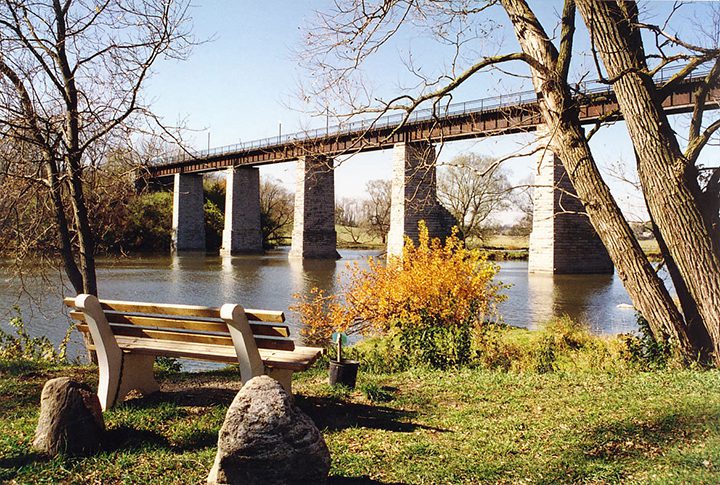Inducted 2012
The re-purposed Sarnia Bridge railway viaduct, once part of the historic Grand Trunk Railway is now the centrepiece of the newly developed Grand Trunk Trail.
In 1858, the Grand Trunk Railway reached the small village of St. Marys from Toronto, transforming the sleepy southwestern Ontario town to a bustling centre. From St. Marys, the line went west to Sarnia and then, on the other side of border, Port Huron and ultimately, Chicago.
When the railway builders arrived in St. Marys, the major challenge for engineers and contractors was the erection of two high railway bridges. One was needed to carry the main line across the Thames River to Sarnia. The other took a spur line to nearby London, across Trout Creek. Both of these large scale bridges required a row of massive limestone pillars to support the girders and tracks.
These 1858 viaducts, described at the time as “the greatest ornament in engineering to any town in Canada West,” immediately became landmarks in St. Marys and are still known as the Sarnia Bridge and the London Bridge. Today, VIA Rail continues to operate the line across the London Bridge to London. However, the line to Sarnia was abandoned in 1989, placing the fate of the wonderful Sarnia Bridge in doubt.
In 1995, the council of the small (population 7,000) town of St. Marys took the bold and visionary move to purchase the Sarnia Bridge from the Canadian National Railway, as well as the right of way within the town along the abandoned line. A citizens’ committee was formed in June 1996 to work towards transforming the old railway line into a trail for everyone to enjoy – residents and visitors alike.
The Grand Trunk Trail was opened in 1998 with over 3 kilometres of paved, accessible trail. The highlight of this walkway is the Sarnia Bridge boardwalk with panoramic views south over the town and north to beautiful countryside. Interpretative signage tells the story of the construction, operation and ultimate repurposing of this railway monument.


